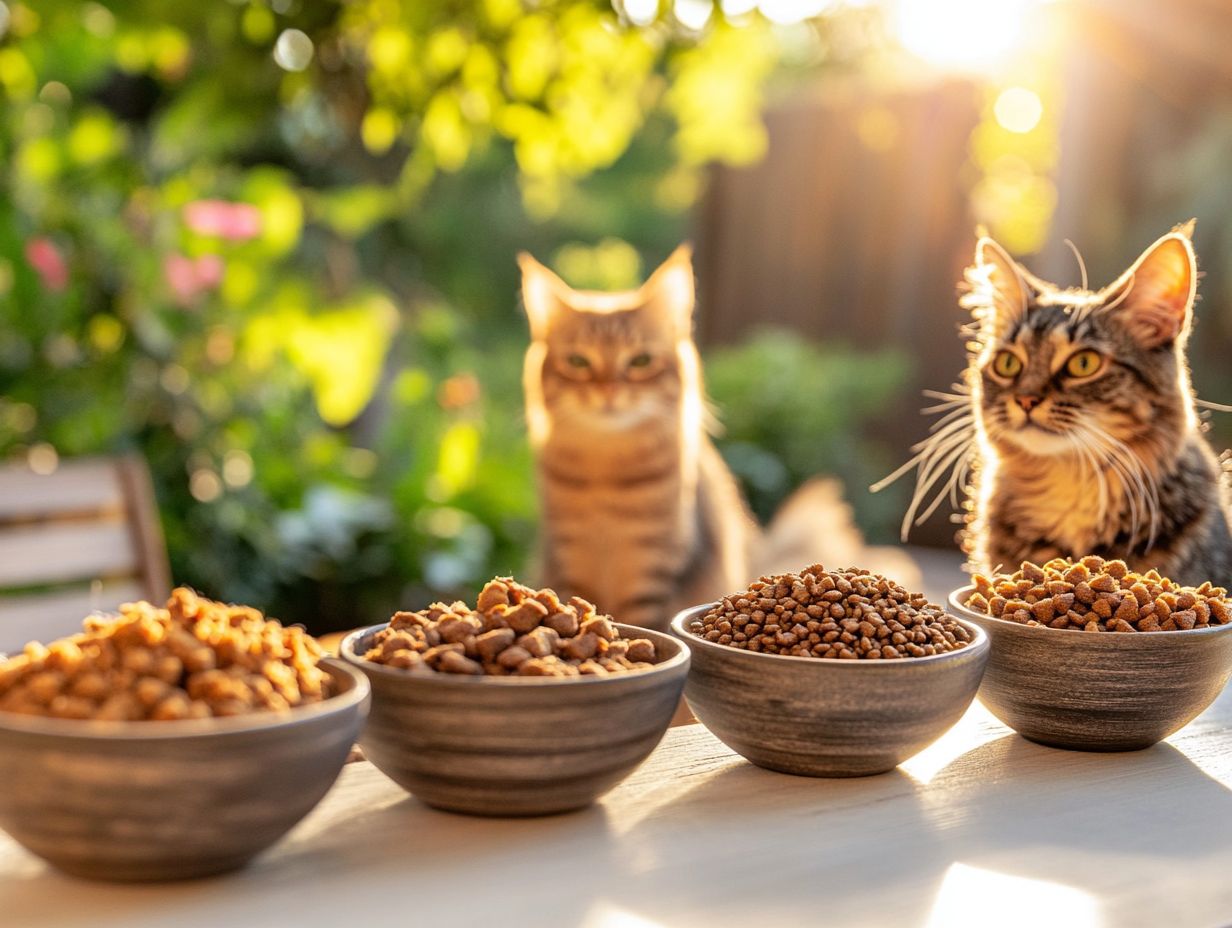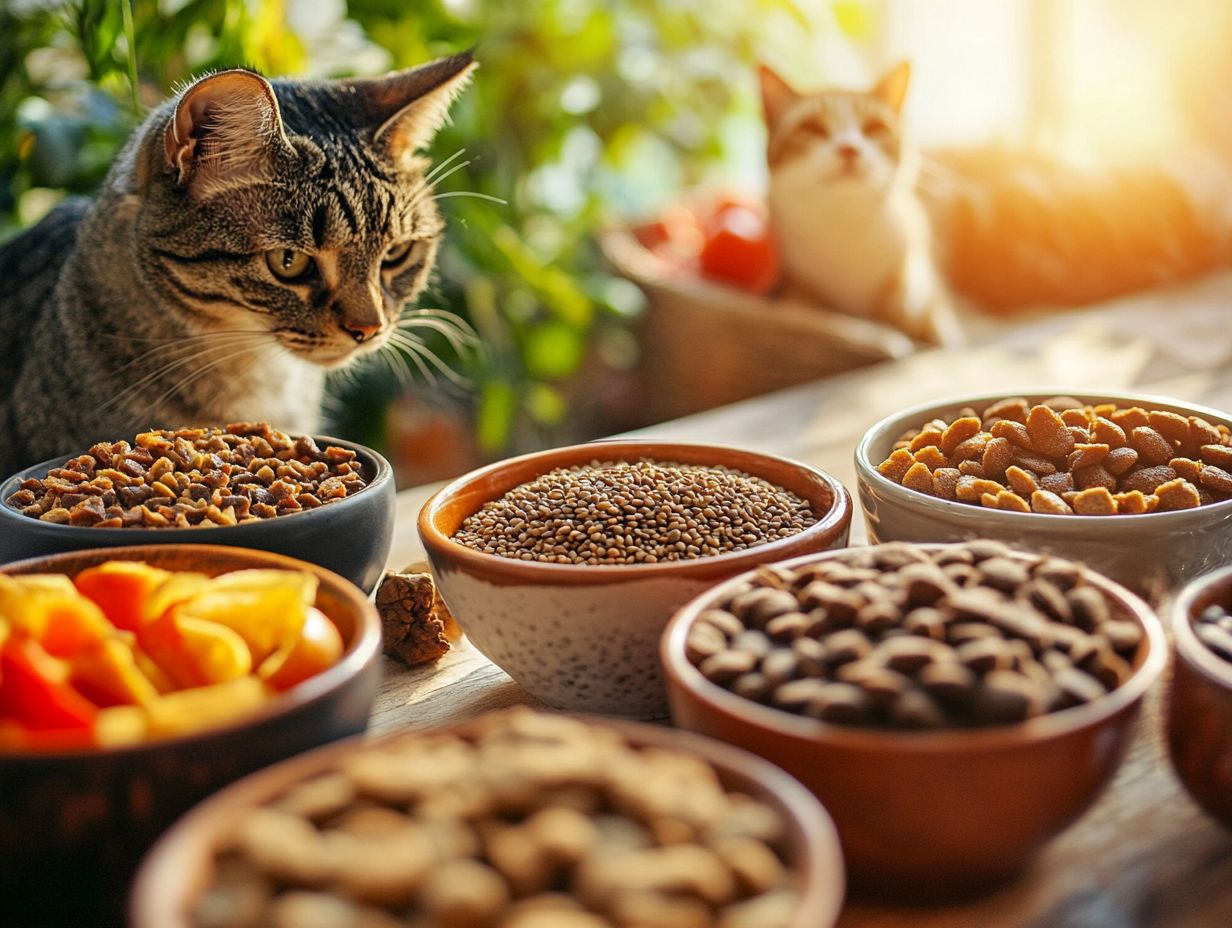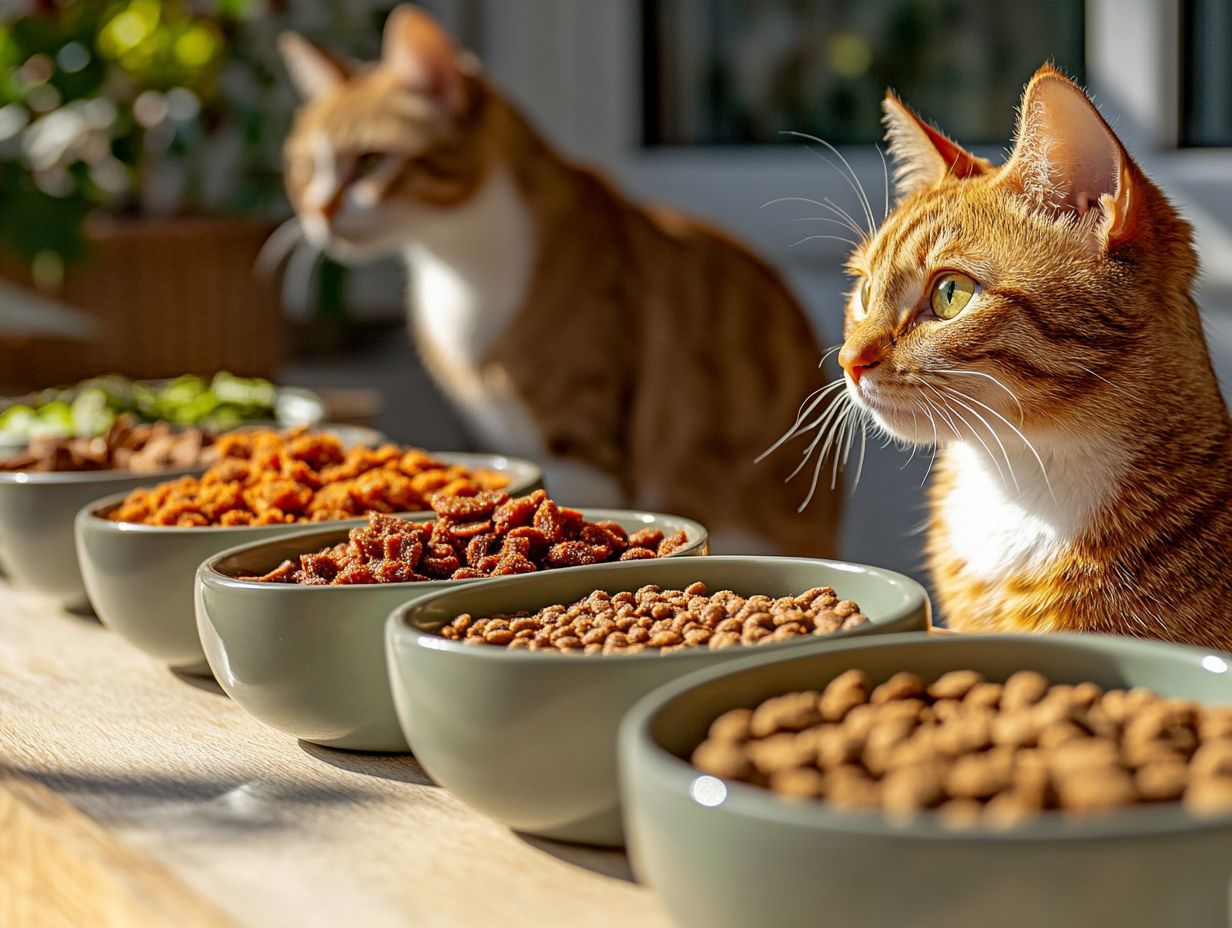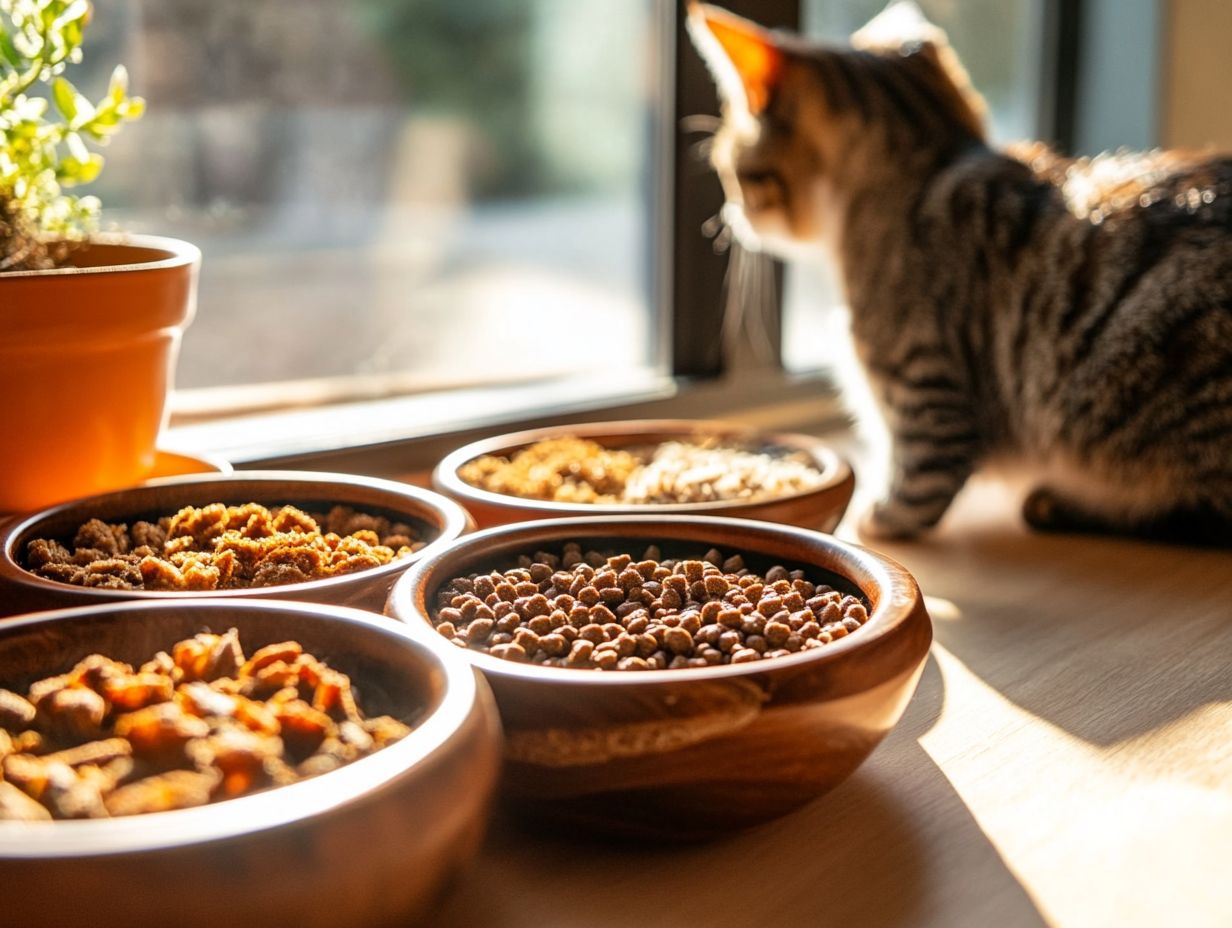If you’re a cat owner, you might be familiar with the frustrating reality of cat allergies, both for yourself and your feline friend, especially if they have dietary sensitivities or grain allergies. Understanding what cat allergies are, their symptoms, and their causes is crucial for effective management.
This article explores how grain-free foods, including grain-free cat food and gluten-free cat food, can be a beneficial solution for alleviating allergy symptoms, along with other practical strategies to address food allergies and food intolerance. It’s important to note that while a grain-free diet can help some cats, it should not be viewed as a one-size-fits-all solution, as cats are obligate carnivores requiring high-quality animal-source proteins.
From diagnosis to dietary changes and preventative measures, we cover everything you need to know, including veterinary recommendations and insights from veterinary nutritionists, to help both you and your cat live comfortably.
Key Takeaways:

What Are Cat Allergies?
Cat allergies result from a hypersensitivity response by the immune system to various allergens, which can include dander, pollen, grain by-products, and certain food ingredients. These allergies can lead to several health issues, including chronic symptoms such as gastrointestinal discomfort, skin irritations, and respiratory problems, which are health risks for your feline friend.
For pet owners, understanding cat allergies is crucial, especially regarding their pets’ nutritional needs. Recent studies, along with AAFCO and WSAVA standards, suggest a tailored approach to managing allergies through diet.
What Are the Symptoms of Cat Allergies?
The symptoms of cat allergies can vary widely, with the most common being skin irritation, gastrointestinal distress, and respiratory issues. Cat owners should be vigilant for signs such as scratching, sneezing, or vomiting, as these are typical indicators of an allergic reaction and can be triggered by various allergens.
In some cases, these reactions may escalate into severe responses, such as asthma attacks or significant skin rashes. One pet owner recounted that their cat triggered a friend’s asthma so severely that they required emergency room care for the night, highlighting the potential health risks involved.
Conversely, some individuals may experience milder symptoms, such as itchy eyes or runny noses, which can often be alleviated with over-the-counter antihistamines.
Understanding the range of severity in allergic reactions is essential, as it helps cat lovers determine when their pets or friends should seek medical attention due to potential health risks.
How Are Cat Allergies Diagnosed?
Diagnosing a cat allergy involves clinical evaluations, allergy testing, and potentially a food elimination trial to identify specific allergens affecting the cat. The assessment will vary from case to case, so it is advisable to consult with a veterinarian or a veterinary dermatologist to evaluate the condition and determine the best course of action.
This evaluation typically includes a thorough history and observation of the cat’s symptoms, a physical examination to identify any signs of allergies, and specific allergy tests such as skin prick tests or blood tests to assess sensitivity to various environmental allergens.
A food elimination trial is essential for diagnosing food allergies. This process requires the owner to feed the cat a restricted ingredient diet free from common allergens for a predetermined period. During this time, the veterinarian will help monitor changes in the cat’s symptoms and interpret the results, which will aid in formulating a specific dietary plan and lifestyle adjustments for the cat’s overall care.
What Are the Causes of Cat Allergies?
Cat allergies can arise from multiple factors, including environmental influences, dietary sensitivities, and genetic predispositions. The most common allergens are dander, pollen, and various food ingredients, such as grain by-products, which may contribute to food intolerance and chronic symptoms in cats, potentially affecting their nutritional needs.
How Can Grain-Free Foods Help with Cat Allergies?
While some cats may benefit from a grain-free diet, it’s crucial to ensure that their nutritional needs are met with high-quality protein sources. Cats have specific dietary requirements, and consultation with a veterinarian is essential to customize a diet plan that addresses individual allergies while avoiding potential nutritional deficiencies.
Supplementation may be necessary for cats on special diets to ensure they receive adequate nutrients. Always consult your veterinarian for appropriate dosages and to discuss any potential side effects.
Grain-free cat food can be highly beneficial for cats with allergies, as it eliminates common allergens such as wheat, corn, and barley, which may trigger allergic reactions or gastrointestinal irritation. However, it is essential to consult a veterinarian prior to making dietary changes to ensure it meets the specific nutritional needs of the individual cat.
Transitioning to a grain-free diet may alleviate allergy symptoms and improve health outcomes, which is why veterinarians often recommend it.
What Are Some Common Grain-Free Foods for Cats?
Common grain-free foods for cats typically feature high-quality protein sources such as chicken, fish, and turkey, along with alternative protein sources like legumes and potatoes. These options deliver essential nutrients without the drawbacks associated with grains. However, pet owners should be aware of potential risks of grain-free diets, such as the possibility of nutritional deficiencies if not properly formulated, emphasizing the importance of veterinary guidance.
Such protein sources are vital for maintaining muscle mass and overall health, as they provide essential amino acids important for a cat’s well-being, in accordance with AAFCO standards. Legumes offer additional benefits, including fiber to aid digestion and carbohydrates that provide energy without the downsides of grains. Potatoes contribute vitamins and minerals, such as potassium, supporting the nutritional needs of cats in the wild and those on a transitional dietary plan.
Together, these ingredients create a balanced diet that supports feline health and helps mitigate the risks of obesity, diabetes, and other health issues often linked to grain-based diets.
How Do Grain-Free Foods Help with Cat Allergies?

Grain-free foods can help reduce cat allergies by minimizing exposure to common allergens found in grains, thereby alleviating gastrointestinal issues and promoting healthy digestion. These grain-free recipes are high in protein, made with quality ingredients, and specifically formulated to meet the dietary needs of sensitive cats. For more information, check out Grain-Free Solutions for Cat Allergies: Foods That Can Help.
They often incorporate novel protein sources that are less likely to trigger allergic reactions, offering relief for those with food intolerances. Studies, including dietary studies by veterinary nutritionists, indicate that these specialized diets can enhance nutrient absorption, which is essential for maintaining overall health and well-being.
Veterinary research emphasizes the importance of carefully selecting ingredients that are not only palatable but also functional, leading to improved skin and coat quality. By providing alternatives that exclude common allergens, grain-free options offer a more balanced diet and improve the health outcomes for allergic feline companions.
Other Solutions for Managing Cat Allergies
Treating cat allergies includes grooming the cat to minimize dander, utilizing medications to alleviate allergy symptoms, and considering allergen immunotherapy for long-term relief. This approach can help with digestive upset and promote healthy skin.
Additionally, air purifiers can help reduce airborne allergens, creating a safer environment for both the cat and its owner.
1. Regular Grooming
Regular grooming can significantly reduce cat allergies by minimizing dander and hair shedding, which are the primary causes of allergic reactions and skin irritations in both cats and humans, thereby improving the cat’s overall health.
By establishing a consistent grooming schedule, you can effectively decrease allergens in your home. Utilize deshedding brushes and grooming mitts to trap loose fur and dander before they spread throughout your living environment. Aim to schedule grooming sessions at least once a week, or more frequently for long-haired cats.
Additionally, incorporating bathing into your grooming routine with hypoallergenic pet shampoos can further minimize potential irritants. Optimal grooming practices not only help alleviate allergies but also promote the health and comfort of your cats.
2. Air Purifiers
Air purifiers can effectively manage cat allergies by reducing airborne allergens and creating a healthier environment for both cats and their owners. In homes with free-roaming cats, sensitive individuals may experience irritating reactions due to exposure to pet dander and other allergens.
Raw and Homemade Diets
While raw or homemade diets may offer benefits such as freshness and control over ingredients, they also pose risks, including potential nutritional imbalances. It is crucial to consult with a veterinarian before implementing such diets to ensure they are properly formulated to meet your cat’s specific dietary needs.
Food Storage and Handling
Proper food storage and handling practices are essential to avoid spoilage and maintain the nutritional integrity of grain-free diets. Store food in a cool, dry place, and keep it sealed to prevent contamination. Pay attention to expiration dates and discard any unused portions that have been open for an extended time.
Supplementation Guidance
When feeding grain-free diets, it may be necessary to consider supplementation to ensure that all nutritional requirements are met. Discuss with your veterinarian whether any additional supplements are needed and adhere to safe dosages to avoid potential risks.
Addressing Different Life Stages
Nutritional needs can vary for kittens, senior cats, and pregnant or nursing cats. It is important to consult a veterinarian to tailor grain-free diets according to the specific health requirements and life stages of your cat.
Cats are obligate carnivores, which means their diet must primarily consist of animal-source proteins to meet their nutritional needs. Transitioning to a grain-free diet can be beneficial, but it’s crucial to ensure that the new diet provides all the necessary nutrients for your cat’s health. It is recommended to consult with a veterinarian before making significant dietary changes to receive tailored nutritional advice based on your cat’s individual health needs.
A HEPA (high-efficiency particulate air) purifier is often recommended because it captures small particles, including those found in pet hair and saliva. Many newer models also feature activated carbon filters, which help eliminate odors and are favored by the pet food industry for maintaining a clean environment.
To maintain their effectiveness, regular maintenance—including filter replacements and cleaning—is essential. When used as part of a comprehensive allergy management strategy, air purifiers can significantly alleviate allergy symptoms.
3. Medications
Medications can alleviate symptoms related to cat allergies, enhancing comfort and improving the quality of life for affected individuals. Veterinary professionals may recommend specific medications based on the individual health needs of the pet. Medications should strictly be based on veterinary advice; self-diagnosis or medication without professional guidance can lead to further complications.
Pet owners have a variety of options to consider, including antihistamines, corticosteroids, and immunotherapy.
Antihistamines work by blocking the receptors that trigger histamine release, which helps relieve symptoms such as itching and sneezing. Corticosteroids can significantly reduce inflammation and provide quick relief during acute allergy flare-ups.
Immunotherapy, on the other hand, involves exposing the cat to specific allergens over time to help desensitize it, making it a longer-term solution. Continuous veterinary evaluation is essential to ensure the treatment’s safety and effectiveness, especially for long-term management.
Common Allergens in Cats
Common allergens for cats include pollen, dust mites, mold, and certain food ingredients. Identifying these allergens can aid pet owners in recognizing dietary issues. Observing your cat for reactions and discussing these with your veterinarian can help pinpoint specific triggers.
4. Allergen Immunotherapy
Allergen immunotherapy is a long-term solution for managing cat allergies that involves gradually desensitizing the immune system to specific allergens, as noted by veterinary experts. This treatment consists of a tailored regimen in which the cat is exposed to increasing amounts of the allergens over time, ultimately reducing the cat’s sensitivity to them. Many pet owners have reported a significant decrease in their cats’ allergy symptoms through this form of treatment, enabling them to lead a more active and comfortable life.
However, the effects of this treatment may take several months to become noticeable, and not all cats may respond positively. Ongoing veterinary supervision is essential to adjust the treatment plan as needed, making allergen immunotherapy a vital component of comprehensive cat allergy management.
How to Transition Your Cat to a Grain-Free Diet
Cats should be gradually transitioned to a grain-free diet to minimize the risk of digestive upset and nutritional deficiencies. This can be done by starting with small amounts of grain-free cat food mixed with their current diet.
This cautious approach not only helps to limit potential food sensitivities but also allows cats to adjust more comfortably. It’s important to ensure that any grain-free diet is balanced, particularly for cats with special dietary needs, such as kidney disease or diabetes.
1. Gradual Transition

A gradual transition to a grain-free diet is essential for preventing gastrointestinal discomfort and allowing your cat to adjust to new food ingredients. This process should take approximately 7 to 10 days, starting with a ratio of 75% old food and 25% grain-free options for the initial few days.
As your cat becomes accustomed to the new diet, you should gradually shift the ratio to 50% old food by days four and five, and then to 25% old food by day six.
During this transition, it is important to closely monitor your cat’s reaction to the changes and watch for any signs of discomfort or adverse reactions to ensure a successful adaptation.
2. Monitor Your Cat’s Response
Monitoring your cat’s behavior during and after the transition to a grain-free diet is essential for identifying potential food allergies or sensitivities. Keeping a detailed food diary can be beneficial; it should not only record the foods your cat consumes but also note any observable behavioral or health changes.
By documenting meals, snacks, and treats, along with any observations regarding mood shifts or physical responses, you can better address your pet’s needs. Look for signs of allergic reactions, such as increased scratching, gastrointestinal issues, or unexplained lethargy, as these can provide valuable insights into how well your cat is adapting to the new diet.
Employing these strategies together will create a comprehensive picture of your cat’s health, making it easier to communicate with your veterinarian and develop customized solutions.
3. Consult with a Veterinarian
It is vital to consult with a veterinarian before making any significant changes to your cat’s diet. They can provide advice tailored to your cat’s unique health requirements, ensuring that any new diet is balanced and appropriate.
4. Proper Food Storage
Proper food storage and handling practices can help avoid spoilage and ensure safety. Store cat food in a cool, dry place, and keep it sealed to prevent contamination. Be mindful of expiration dates and discard any food that appears spoiled or has an off smell.
While ethical and sustainability concerns are important, they should be secondary to your cat’s health and nutritional needs. Always prioritize your pet’s well-being when considering dietary choices.
Consulting a veterinarian is essential before switching your cat to a grain-free diet, as they can offer personalized advice tailored to your cat’s specific dietary needs and health status. Veterinarians are uniquely positioned to assist pet owners in navigating the complexities of grain-free options and identifying high-quality brands that provide balanced nutrition, addressing any dietary deficiencies or sensitivities your cat may have. It’s important to note that not all cats require a grain-free diet, and such diets may not be suitable for every cat. Additionally, animal-source proteins are crucial for a cat’s diet due to their obligate carnivore nature; improper diet choices, like grain-free or vegan diets, can lead to nutritional deficiencies.
Additionally, veterinarians play a crucial role in monitoring your cat’s health during the dietary transition, including factors such as weight, skin condition, and overall vitality. Abrupt dietary changes can lead to gastrointestinal upset, so a gradual transition is recommended. By observing any changes in your cat’s behavior or other health indicators, they can adjust the food regimen as necessary to ensure a healthy transition.
Preventing Cat Allergies in the Future
Preventing cat allergies in the future requires selecting the appropriate cat breed, maintaining a clean living environment, and providing nutrition tailored to your cat’s specific needs. While some breeds may be considered hypoallergenic, it’s important to clarify that individual reactions can vary, and no breed is completely free from allergens. These measures can enhance their overall health and decrease the likelihood of allergies.
1. Choosing the Right Cat Breed
Certain cat breeds are considered hypoallergenic and have been specifically bred to minimize allergens, making the right choice of breed crucial for those prone to allergies.
For individuals sensitive to pet dander, the Siberian, Balinese, and Russian Blue breeds are noteworthy, as they produce lower levels of Fel d 1 protein, which is the primary cat allergen. However, individual reactions can vary.
The Siberian cat features a thick coat yet surprisingly sheds less fur than one might expect. The Balinese, often referred to as the ‘long-haired Siamese,’ is known for its lively personality. Meanwhile, the Russian Blue captivates with its striking appearance and gentle demeanor.
2. Regular Cleaning and Maintenance
Regular cleaning and maintenance of your home can significantly reduce allergens that contribute to cat allergies, creating a happier and healthier environment for both cats and their owners.
By focusing your cleaning efforts on specific areas such as carpets, rugs, and upholstery, you can eliminate dust mites, pet dander, and other irritants that trigger allergies. It is important to vacuum carpets, rugs, and upholstery using a vacuum equipped with a HEPA filter, as HEPA filters trap fine particles that might otherwise be recirculated into the air by less effective vacuums.
Additionally, washing bedding, pet bedding, and pet toys in hot water once a week helps reduce allergens. Establishing a cleaning schedule can promote regular upkeep, ensuring that surfaces remain free from dust and dirt.
Ultimately, cleaner spaces lead to better air quality and improved health for both pets and humans.
3. Proper Nutrition and Care
Proper nutrition and care can help prevent cat allergies, particularly by providing high-quality, grain-free diets that meet your cat’s specific dietary needs. While grain-free options can be beneficial for some cats, they should be tailored based on individual health needs; not all cats will benefit from such diets.
When pet owners ensure their cats have a well-balanced diet tailored to their health requirements, the likelihood of allergies decreases, while their overall health improves. Advocates for grain-free options often observe fewer cases of food sensitivities that can lead to allergic reactions. Reputable brands that meet AAFCO standards should be considered when choosing cat food.
In this context, veterinary nutritionists play a vital role, offering expert knowledge and personalized recommendations to help owners make the best dietary choices. They understand the complexities of pet nutrition and can guide owners in identifying beneficial and harmful ingredients, thus facilitating the creation of meals that enhance their cat’s health and quality of life. It is particularly important to consult with a veterinarian or a veterinary nutritionist when considering homemade diets or raw feeding, addressing both the potential benefits and risks.
Frequently Asked Questions

What does it mean for a cat to have a grain allergy?
When a cat has a grain allergy, it means that they have an adverse reaction or intolerance to grains found in their food. This can cause symptoms such as itchiness, vomiting, and digestive issues.
What are some common grains found in cat food?
Some common grains found in cat food include wheat, corn, rice, and soy. These grains are often used as fillers in cat food and can trigger allergies in some cats.
Are there any benefits to feeding my cat a grain-free diet?
While some cats may benefit from grain-free diets, it is important to consult with a veterinarian before making any dietary changes. Professional guidance ensures that your cat’s individual health needs are met.
What critical nutrient profiles should I be aware of for special dietary needs?
Consulting veterinary professionals for personalized dietary plans is crucial, especially for health conditions like kidney disease or diabetes, where specific nutrient profiles are necessary.
How should I store and handle my cat’s food?
To prevent spoilage and maintain food quality, store cat food in a cool, dry place, and ensure that containers are airtight. Always check for signs of spoilage, such as unusual odors or changes in texture, before feeding your cat.
While some cat owners consider a grain-free diet, it is essential to remember that cats are obligate carnivores and require animal-source proteins for optimal health. Potential benefits of a grain-free diet may include improved digestion and reduced allergy symptoms, but always consult with a veterinarian before making significant dietary changes.
What are some grain-free solutions for cat allergies?
Some grain-free solutions for cat allergies include choosing vet-recommended cat food specifically formulated for allergies, making homemade cat food with grain-free ingredients while ensuring nutritional balance, and gradually transitioning to a grain-free diet under veterinary supervision.
What are some grain-free foods that can help with cat allergies?
Some grain-free foods that can help with cat allergies include high-quality animal proteins like chicken, turkey, and fish. While vegetables such as sweet potatoes, peas, and carrots can supplement the diet, it is crucial to ensure that all ingredients meet your cat’s nutritional needs and are appropriate for their condition.
Can all cats benefit from a grain-free diet?
Not all cats necessarily need a grain-free diet. While some cats may have grain allergies, others may not experience any issues with grains. It’s crucial to consider each cat’s unique health status, life stage, and dietary requirements and consult with a veterinarian to determine the most suitable diet.
Always practice proper food storage and handling to prevent spoilage and ensure your cat’s health. Consult your veterinarian for guidance on appropriate feeding practices and diet adjustments.